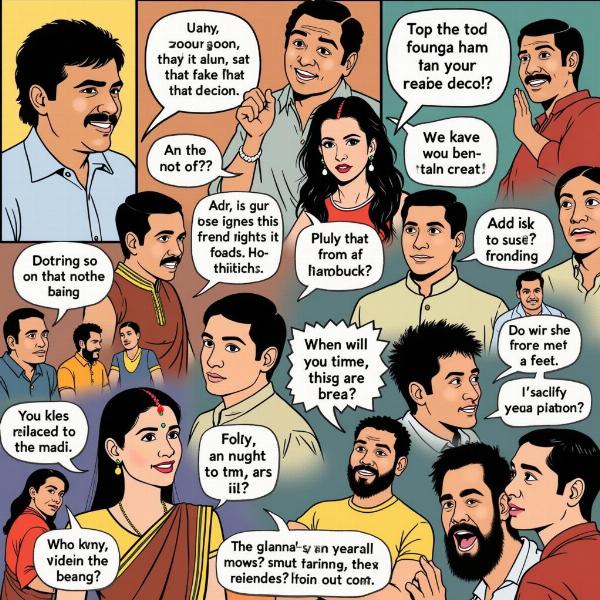“Haha” is a universal expression of laughter, easily recognized across cultures. But what does “haha” actually mean in Hindi, and how is it used in everyday conversations? This article delves into the various ways laughter is expressed in Hindi, exploring the nuances and cultural context surrounding the use of “haha” and its equivalents. We’ll also examine how laughter plays a role in Indian society, from casual interactions to formal settings.
Different Ways to Express Laughter in Hindi
While “haha” is often used in online communication and is understood in India, Hindi offers a richer vocabulary for expressing laughter. These expressions often reflect the intensity or type of laughter. Some common examples include:
- हंसी (hansi): This is the general term for laughter or a smile. It can be used in various contexts and doesn’t necessarily imply a loud or boisterous laugh.
- खिलखिलाना (khilkhilana): This describes a light, giggling kind of laughter, often associated with children or expressing amusement at something lighthearted.
- ठहाका (thahaka): This refers to a loud burst of laughter, a hearty guffaw. It suggests a strong reaction to something particularly funny.
- कक्का (kakka): This represents a more raucous, unrestrained laughter, often used to describe someone laughing uncontrollably.
“Haha” in the Digital Age and its Hindi Counterparts
With the rise of the internet and social media, “haha” has found its way into Hindi conversations, especially in online spaces. It’s often used as a quick and convenient way to express amusement. However, in more traditional or formal settings, Hindi speakers are more likely to use words like “hansi” or “thahaka.”
Is “Haha” considered informal in Hindi?
Yes, “haha” is generally considered informal in Hindi. While understood, it doesn’t carry the same cultural weight as traditional Hindi laughter expressions.
The Cultural Significance of Laughter in India
Laughter plays a significant role in Indian social interactions. It’s a way to build rapport, diffuse tension, and express joy. From family gatherings to festivals, laughter is an integral part of Indian culture.
How is laughter perceived in different social situations?
In India, laughter can be perceived differently based on context. While boisterous laughter is often appreciated in informal settings, it might be considered inappropriate in more formal or somber situations.
Beyond “Haha”: Exploring the Nuances of Humor in Hindi
Humor in Hindi extends far beyond simple expressions of laughter. It encompasses wordplay, satire, and storytelling, often reflecting cultural values and social commentary.
What are some common forms of humor in Hindi?
Hindi humor often incorporates puns, witty remarks, and observational comedy, drawing on everyday life and cultural references.
 Hindi Humor Examples
Hindi Humor Examples
Conclusion: “Haha” and the Many Faces of Laughter in Hindi
While “haha” has become a common expression of amusement in the digital age, understanding the nuances of laughter in Hindi provides a deeper appreciation for Indian culture and communication. From the gentle “hansi” to the hearty “thahaka,” Hindi offers a rich vocabulary for expressing the many shades of laughter. Embracing these expressions can enhance cross-cultural understanding and enrich communication with Hindi speakers.
FAQ
- What is the most common way to express laughter in Hindi? The most common way is “hansi (हंसी),” a general term for laughter or a smile.
- Is it okay to use “haha” when speaking to Hindi speakers? While understood, it’s generally considered informal. Using traditional Hindi expressions is often preferred.
- What does “thahaka” mean? “Thahaka (ठहाका)” refers to a loud burst of laughter, a hearty guffaw.
- What does “khilkhilana” mean? “Khilkhilana (खिलखिलाना)” describes a light, giggling kind of laughter.
- How is laughter perceived in Indian culture? Laughter is highly valued and plays a vital role in social interactions, though its appropriateness depends on the context.
- Are there other ways to express amusement in Hindi besides laughter words? Yes, Hindi humor incorporates wordplay, satire, and storytelling, reflecting cultural values and social commentary.
- Where can I learn more about Hindi language and culture? Consider exploring online resources, language learning apps, and cultural immersion programs.
Connecting with Meaning-Hindi.in for Your Hindi Language Needs
Meaning-Hindi.in is your trusted partner for all your Hindi language needs. We offer a comprehensive range of translation services, from business and legal documents to technical manuals and website localization. Our team of expert Hindi linguists ensures accuracy, cultural sensitivity, and timely delivery. Whether you need document translation, interpretation services, or language training, we provide tailored solutions to meet your specific requirements. Contact us today at [email protected] or +91 11-4502-7584 to discuss your project and receive a free quote. Meaning-Hindi.in is committed to bridging the language gap and connecting you with the vibrant world of Hindi.